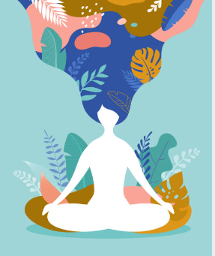
Why is “letting go” so hard?
As the seasons transition from fall to winter and the harvest season completes, the trees shed their leaves, and animals ready themselves for the long, cold, darkness ahead. Nature understands change is necessary. For the mortal kind, we tend to resist change at all costs. For attorneys trained to be risk-averse, change and ambiguity can cause tremendous discomfort.
Buddhism teaches about the fundamental concept of impermanence (in Pāli it’s called “anicca”); the only constant is change. We might understand this as true and yet we resist the discomfort caused by uncertainty. As a result, we suffer. According to the words of Dhamma (aka “Universal Law”):
All things are impermanent
when one observes this with insight,
then one becomes detached from suffering;
this is the path of purification.
Late last August, I sat in a 10-day silent meditation retreat called Vipassana, a Buddhist practice of “insight.” I was there because change was happening in my life, and I knew I needed to turn inward to face it. For each of those days, down to the hour (if not the minute), I was instructed to explore what was arising within me from the level of bodily sensations. Over a short period of time, I started to notice how steadfast I was in attaching meaning and stories to the emotions that arose from such sensations. The old, familiar recording that would play on repeat, “I’m not good enough, there’s something wrong with me, I’m a bad person.” I knew these weren’t loving or compassionate beliefs. They were formed earlier on in my life as a defensive strategy to cope with painful life experiences. “If I feel hurt, sadness, rejection, I must deserve it.” These beliefs were keeping me suspended in time, trapped. A few days into the retreat and I could feel how resistant my mind was to letting them go.
As the days continued, there was a voice deep inside me getting louder, “if I don’t cling to these beliefs then what? Who am I if I let go?” I persisted in my suffering, through the silence, in meditation. Then, on the morning of the 4th day, I broke. It was as if my mind, terrified to relinquish control, grew too weary to hold on any longer. I was in a panic. Sensations arose in my body so dramatically that I thought I was having a heart attack at 5 am during the morning sit. I didn’t know what to do and remember thinking almost comically, “if I’m dying, I should get help, but also, can I ask for help while observing noble silence?” When I could finally find my feet underneath me and reconnect to the earth and my breath, the fear slowly started to dissipate. My mind went quiet, and my body gently quivered. I was overcome with a sense of relief. This relief, as I came to recognize it, was in part because I didn’t die, sure. But it was also because I felt a new sense of aliveness in letting go.
This grasping for control was a subconscious clinging to what felt safe (these beliefs around worthiness, lovability, etc…). On the other side of letting go was a real fear of uncertainty, questioning whether it was safe to let go and surrender to the unknown. After that morning’s experience, I was ever more humbled by how powerful the mind-body connection is to how we relate to ourselves and our existence. That panic attack allowed for a breakthrough of my mind’s resistance to let go. It also corresponded with a somatic opening, which released energy previously bound in my solar plexus as a long-held contraction. During breaks, I would retreat to my bed and move into Child’s Pose, which felt safe, allowing the tears and mucus to pour out of me while feeling intense streaming, pulsing vibrations running through my back body. Over the remaining retreat, I began to witness sensations with an awareness of nonattachment, allowing stories, thoughts, and beliefs to come and go with less resistance.
Somatics, much like insight meditation, is a pragmatic field of study and practice in how we relate to ourselves and to the world around us. It is a methodology of transformation. By cultivating somatic awareness, we can learn how our body is both the site of shaping and the site of change. Somatics begins at the level of sensation (as the building blocks of life), which directly connects to our nervous systems and how we react to our environments. While we are designed to move toward life and naturally gravitate toward what brings us a sense of safety, dignity, and belonging, our nervous systems are designed to protect us from danger and what we perceive as a threat to our safety. This is a real or perceived danger. This brilliant system of survival is part of our reptilian brain and will get us out of a burning building, and it will also keep us frozen in shame.
As I learned on that 4th day, the fear of uncertainty can arise to the level of perceived danger. As a result, we can often feel safer living inside the discomfort of what is familiar rather than exploring that which is unknown. As attorneys, we often rely on predictability and attach to creating logical outcomes. Our clients depend on it. We can carry this tendency as a burden into our personal lives and, as a result, feel ever-more resistant to change. Somatic practices can help us face uncertainty and fear by regenerating a sense of safety. This enables us to experience new possibilities for how we want to relate to life, to ourselves, and to one another.
CULTIVATING SOMATIC AWARENESS
To practice “letting go,” we can begin by cultivating somatic awareness as to what is occurring at the level of sensations. Let’s start by feeling the sensation of temperature on our skin. Notice where there may be heat or parts of you that feel cold. You can also feel for any contact you’re making with the earth (your back against your seat, your feet on the ground, etc…) or the experience of your heartbeat or any pulsing or vibrations you can notice below the surface. Take your time to feel for what is arising. Imagine turning up the dial on this experience 10-15% to exaggerate the experience. Similarly, try turning that dial down 10-15%. As you practice noticing what is arising, pay attention to the changing nature of these sensations as well as the changing nature of your thoughts. See if you can let them pass as you continue to stay attuned to sensation.
Now, let’s practice switching your attention from what is occurring inside your body to what is occurring in the environment around you by focusing on what you see and hear. Can you get even more curious about the noises you hear at a distance or the details of what you’re looking at? Imagine turning up the dial 10-15% before turning it down 10-15%. As you attune to what is arising, can you stay present to the experience of noticing?
As we develop our embodied self-awareness, we can become more conscious of how we attach to certain beliefs, stories, and narratives about ourselves. How can you use this somatic practice throughout your day to help you become more present to what is arising in order to interrupt any resistance you may have to letting go?
Impermanence teaches us that the only constant is change. Somatics helps us shape change. We can begin at the level of sensation.

